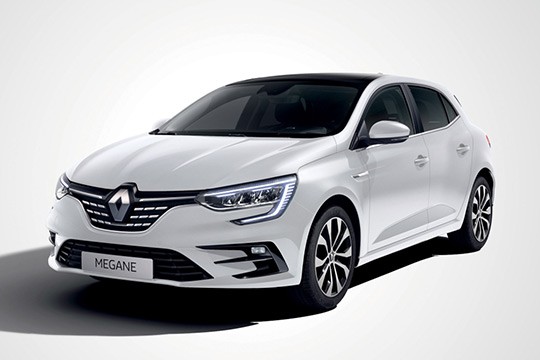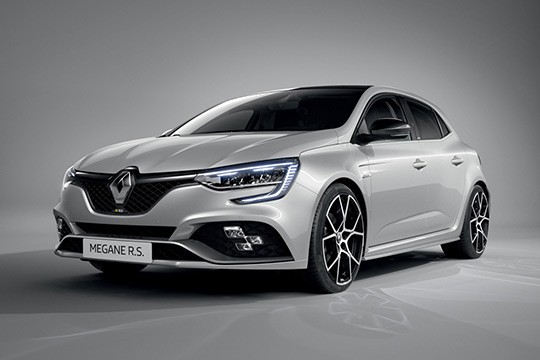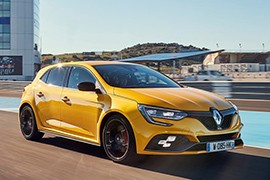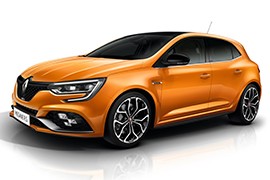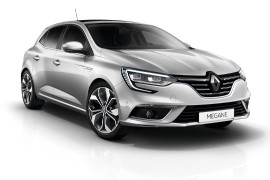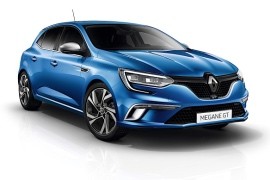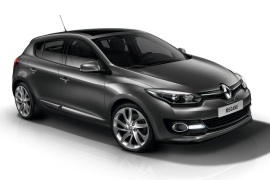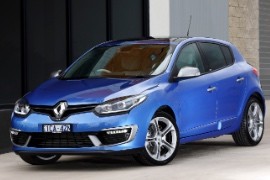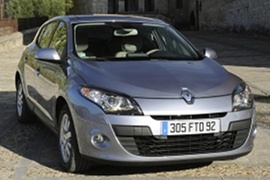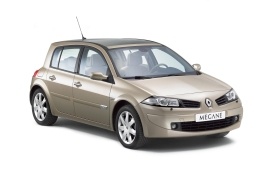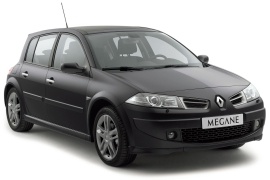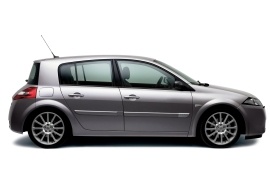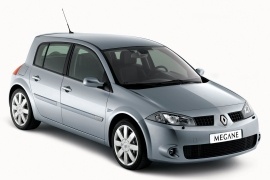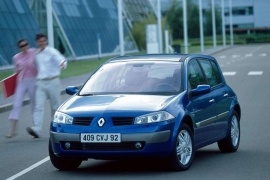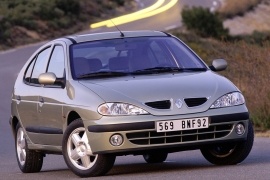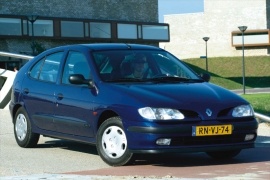RENAULT Megane 5 Doors Models/Series Timeline, Specifications & Photos
First production year: 1996
Engines: Gasoline, Diesel, Hybrid
Body style: Hatchback
The benefits of E-Tech Plug-in, inspired by Renault Formula 1 expertise, combines the obvious advantages of an electric drive (such as low noise, immediate responsiveness and reduced fuel consumption) with energy recover technology and an ICE engine.
With its 9.8 kWh battery, the sleeker Renault Megane has a range of 50 kilometers in mixed cycle and up to 65 kilometers over an urban cycle, without using the combustion engine, thus proving its versatility in the long weekend journeys or for holidays. he E-Tech Plug-in technology was developed by Renault Engineering and it pairs the said battery with a 1.6-liter 4-cylinder petrol engine (160 hp) and two electric motors offering a unique driving experience.
In this hardware configuration, the Megane E-Tech can be driven on 100 % electric power at speeds up to 135 km/h.
Even though the car has similar design and dynamic with its predecessors, the New Renault Megane has become slicker than ever before. Like the entire range, it comes with an integrated 9.3-inch screen and the Renault Easy Link multimedia system, as well as the new 10.2-inch TFT digital speedometer.
Renault has also enhanced safety and comfort by adding Pure vision LED headlamps for improved visibility and new driving aids, including the Motorway and Traffic Assistant.
Renault introduced an improved version of the Megane R.S. in 2020, offering customers more power to play with and even a six-speed manual gearbox, which made purists happy.
The French automaker refreshed the entire Megane lineup for the 2020 model year, and the R.S. version was also upgraded. While there were just subtle exterior changes, the interior was revised, and the drivetrain was improved as well. Under the hood, the French automaker planted an engine carried over from the 2017 Alpine A110 sports car, and that made a consistent difference for the hot hatch.
At the front, the 2020 Megane R.S. featured similar LED headlights with C-shaped daytime running lights on their outer areas, similar to the rest of its siblings. The automaker placed the chromed rhomboidal badge between them on the slim upper grille, cutting a piece from the hood. Furthermore, Renault applied some design lines featured on the Renault Formula 1 race cars, featuring a waved-shaped lower splitter fitted inside the apron. The fog lamps looked like checkered flags, with three rectangular lamps on each side.
From its profile, the five-door hatchback boasted its large alloy wheels that covered the big brakes and the red Brembo calipers. Unlike the rest of the Megane range, the R.S. version came fitted with exhaust vents on the front fenders that released the air trapped inside the wheel wells and lowered the front axle lift. Moving to the doors, these featured sculptured lines and black door mirror caps. The chromed line surrounding the window area was similar to the non-facelifted version of the Megane R.S. Finally, at the back, the French hot hatch sported a center-mounted trapezoidal exhaust integrated into the diffuser.
Inside, customers could get the Megane R.S. with a new 9.3” portrait-mode infotainment screen mounted on top of the center stack. At the front, the automaker offered either regular bucket seats or high-bolstered sports ones. A center console between them housed the parking brake, the gear stick, and a pair of cup holders. In the back, Renault installed a bench seat suitable for three adults, although there was virtually no legroom for the middle-seated one. The trunk was quite large for its size, and since the bench seat was split-folding (60/40) type, it could be enlarged to reach a maximum space of 1,247 liters (44 cu-ft).
But the Megane R.S. was mostly about performance and fast driving. It was a car that broke records on various race tracks around the world for front-wheel-driven vehicles, competing in the same segment as the Honda Civic Type R and the Volkswagen Golf GTI. Its refreshed 300 PS (295 hp) powerplant was paired with either a six-speed manual or a six-speed automatic (dual clutch). A Cup chassis fitted with stiffer dampers, thicker antiroll bars, and a limited-slip differential were on the options list.
The fourth generation of the Megane appeared on the market in 2016, and it was available in a few versions, but the most awaited of them was the RS, which Renault introduced in late 2017.
As one of the most successful European automakers, Renault was keen to prove its ability to produce sports cars. The French brand was connected with the motorsports world to the highest levels and had many Formula 1 World Championship titles under its belt as an engine manufacturer.
Moreover, it had a separate department that created performance-oriented vehicles, namely the Renault Sport, which was responsible for creating sports cars such as the Clio R.S. or the Megane RS. These were among the best on the market, challenging other hot hatches such as the Honda Civic Type R and the Volkswagen Golf GTI, to name just a few.
In September 2017, Renault unveiled the Megane RS at the Frankfurt Motor Show. Unlike its predecessors, which were available as three- or five-door hatchbacks, this came just in a five-door version. The French automaker noticed that customers started to be less attracted by the sportier-looking three-door bodyworks and chose the more practical five-door ones. The car shared almost nothing with its non-RS sibling.
At the front, it featured a distinct fascia adorned by the RS badge on the grille and a bumper that sported an apron filled by side scoops, checker-flag-styled LED daytime running lights, and a center air intake divided into two parts. From its profile, the 2018 Megane RS showed its specific front fenders, which were slightly wider than the non-RS version due to the different suspension. In addition, it featured extracting vents on the front fenders.
The aerodynamic side sills created a connection with the rear quarter panels that were wider than on the regular Megane. Finally, at the back, Renault Sport created a unique-looking bumper that featured a center-mounted exhaust flanked by a diffuser. On top of the tailgate, it also added a wider roof spoiler than on the rest of the range.
Changes continued on the inside, where Renault installed a pair of Alcantara-covered Recaro sports seats that hugged their occupants and kept them safe during high-speed cornering maneuvers. The driver fronted a digital instrument cluster where the tachometer took center stage. A flat-bottom steering wheel that sported the RS badge on the lower spoke, and the aluminum pedals completed the sporty image for the driver.
Atop the center stack, Renault installed a portrait-mode infotainment system named R-Link that featured a specific menu named R.S. Monitor, which could record the car’s performance on a track and help drivers improve their lap times by showing them braking points and race lines. In the back, the automaker added a split-folding bench that could expand the trunk.
Renault offered the Megane RS with one engine option, a 1.8-liter turbocharged four-pot, and two engine choices: a six-speed manual or a seven-speed automatic (dual-clutch) gearbox with launch control. Furthermore, those who opted for the Cup Chassis got a limited-slip differential and a lower, stiffer suspension than the regular Megane RS.
The Renault Megane RS was a total surprise when it came to the market and hit the hot-hatch segment with a car that could deliver more performance than the iconic VW Golf GTI.
The third generation of the Renault Megane RS came in 5-door version and that was a good thing. While it didn't have the sporty look of a three-door hatchback, it had more practicality. It was based on the mass-volume car Renault Megane and shared the same suspension with that. But a Cup chassis was available as an option and that offered stiffer suspension and a limited-slip differential
From the outside, it was easy to identify a Megane as an RS version due to its checker-flag like fog-lights in the front bumper. The front fenders featured flared wheel-arches and side scoops to extract the air from the wheel-well. The rear bumper was specific for the RS. It featured a trapezoidal middle exhaust and a diffuser underneath. On top of the tailgate, there was a roof-spoiler to enhance the aerodynamic.
Inside, the RS had Alcantara everywhere: on the dashboard, on the bucket-type seats, and on the door panels. Of course, those were offered as an option. Also, an option was the large, portrait type, infotainment touch-screen display. The standard unit was a 7" in a landscape mode.
For the powertrain, there were two options: either a 280 hp version or a more aggressive 300 hp. Both were available with either a 6-speed manual or a 6-speed automatic dual-clutch with paddle shifters behind the steering wheel. For better handling, it featured a four-wheel steering as standard.
Renault launched the fourth generation of its successful model Megane in 2015 at the Frankfurt International Motor Show, and the five-door version was the most important from its lineup.
With an increased demand for compact hatchbacks on the European market, Renault had to stay ahead of the curve and show up with something innovative. And that’s what it did and surprised everyone not just with the shapes of its new model but also with the technical solutions unseen by similar competitors. The five-door version was the most important in the lineup since it enjoyed the biggest sales among its siblings, and customers considered it a serious alternative to the Golf.
The car’s exterior continued the idea of organic shapes introduced in the third generation of this moniker but evolved with more styling cues and upscale details. At the front, the taller headlights featured a C-shaped signature daytime running light that cut into the bumper. Lower, in the air dam, the automaker added a grille that cooled the engine and two side scoops for the fog lamps when fitted. From its profile, the ascending beltline and the enlarged rear quarter panels gave a muscular look to the vehicle. Finally, a roof spoiler adorned the tailgate at the back, and the unusually wide taillights were almost stretched from one side to the other of the car.
But it was the interior that grabbed anyone's attention. Before this generation, the Megane didn’t offer too many features for its customers. Still, along with the fourth generation of this nameplate, it evolved. The base versions were fitted with regular analog dials and a stereo on the center stack. There was nothing to write home about it. For the upper trim levels, on the other hand, the automaker gave anything it had in its baskets. As a result, a fully digital instrument cluster stood in front of the driver. In addition, a portrait-mode 8.7” touchscreen adorned the center stack, and Renault installed its R-link infotainment system on it. In addition, the automaker worked together with Tom-Tom for the navigation system and offered customers the option for live traffic service. The standard seats were quite mundane for this car, but the upper grades got high-bolstered ones for the front occupants, while the rear split-folding bench seat was good enough for three children or two full-size adults.
From the technical point of view, Renault surprised the market with the introduction of the 4Control system, which allowed four-wheel steering. While this feature was already available on large cars, no other automaker installed it on a compact-sized hatchback. For the powertrain, the French automaker offered a wide choice of engines ranging between 89 HP (90 PS) and 163 HP (165 PS) paired with either five- or six-speed manuals or six-speed automatics (dual-clutch). Moreover, those who desired punchier engines could get the GT version, which offered over 200 ponies.
Renault unveiled the fourth generation of the Megane in 2015 at the Frankfurt Motor Show and, besides the rest of the range, it also offered a unique trim level named GT.
With an increased demand for hot hatches suitable for family duties, the French automaker understood that it had to come up with something different on the market. Thus, it used the experience of its motorsports department and blended it with some knowledge from the rest of the Megane range.
At the front, a daytime running light encircled the headlights, giving the car a distinctive personality. But that was not enough for the French carmaker, and it asked the Renault Sport division from Dieppe to improve the five-door hatchback, who created a new front bumper with a sportier look. In addition, they added a lip spoiler at the bottom that reduced the ground effect. Moreover, they added a pair of scoops on the sides for the fog lamps. A roof spoiler adorned the tailgate and improved the airflow at the back of the car. All design elements were functional and weren't there just for a sportier appearance.
The interior continued the idea of a sporty vehicle, with high-bolstered bucket seats for the front occupants and a split-folding bench seat at the back wide enough to fit three passengers. On the center stack, Renault added a big R-Link infotainment system. At the same time, on the center console, a special button marked with a flag started to raise questions about the car's character.
The drivetrain was different than the rest of the Megane range. A 4-wheel steering system named 4-control was installed, which helped the car get faster around the corners. The Megane GT featured a standard, 6- or 7-speed automatic (dual-clutch) transmission with paddle shifters (depending on the engine).
Renault unveiled the facelifted version of the Megane's third generation at the 2013 Frankfurt Motor Show, and the five-door version was one of the main attractions to the automaker's booth.
Europe was preparing to enforce new emission standards, and not all automakers had everything they needed to comply with those. On the other hand, Renault did its homework and prepared the facelifted version of the Megane to fit into the new emission standards.
While the carmaker was already working on the fourth generation of the Megane, it didn't want to invest too much in the facelift. Yet, it added a new front fascia that sported a big badge on the grille instead of on the hood as on its predecessor. Moreover, the headlights received an update with a new design. At the same time, the bumper sported the LED daytime running lights placed lower on the side scoops. However, the car's profile remained unchanged, with the same arched roofline and the sloped tailgate, in the Kamm-back styling.
Inside, the main difference was the new R-Link infotainment system placed above the center stack. That brought the French automaker closer to its main competitors, even though Renault knew that it wasn't such high demand among its customers. But, just like its predecessor, the 2014 five-door Megane featured a 60/40 split-folding rear bench. Thanks to that, it could expand the trunk area from its regular 371 liters (13.1 cu-ft) up to 1,162 liters (41 cu-ft).
Under the hood, the engine lineup was upgraded to Euro 6 emission standards. In addition, Renault introduced a new 1.33-liter turbocharged gasoline unit and a dual-clutch automatic gearbox.
Renault struggled to get more customers for its compact-sized model Renault on the European market and introduced the GT lineup in 2013.
The third generation of the Megane lineup broke covers in 2008, and customers liked it. But then, during the world financial crisis, sales were slow. Afterward, the French automaker did everything it could to recover and gain momentum when the market bounced back. One way that Renault considered improving sales was to expand the GT trim level to the five-door version, which it unveiled in 2013. As a result, customers who dreamed about having a sporty but also family-friendly hatchback could get this car and enjoy driving it. While it wasn't exactly a hot hatch, it was good enough for most situations.
Along with the facelifted version of the Megane's third generation came a restyling for the front bumper that was enhanced with the addition of LED daytime running lights. The GT version added a new apron with an A-shaped center air intake and a pair of side scoops that flanked it. A set of light-gray inserts adorned the air dam, creating an even sportier look for the car. In addition, the upper grille, painted in piano black, sported a silver GT badge in the middle, underneath the carmaker's logo. Another element that differentiated the GT from the rest of the range was the black headlamps' background.
From its profile, the GT boasted its 18-inch aluminum wheels wearing 225/40 tires from Michelin. Renault also lowered the ground clearance for the GT version to the same level as the Megane Coupe. But that wasn't all. A set of aerodynamically profiled side sills and satin-silver elements for the door mirror caps and handles emphasized the car's sporty character. At the back, the automaker added a roof spoiler at the top of the tailgate, while underneath the rear bumper was a neatly concealed diffuser.
Inside, the front bucket seats with high-bolstered areas and thigh support emphasized the vehicle's sporty character. Full-leather upholstery was available for all seats. Fronting the driver was the same instrument cluster as in the rest of the Megane range, with a speedometer in the middle flanked by the tachometer on the left and a digital display on the right for various information from the car's onboard computer. Atop the center stack, Renault installed the display for the infotainment system that could've been controlled by a small turning knob and a few buttons around it housed by the center console. In the back, the split/folding bench seat could accommodate three adults for short trips or two for longer journeys.
Under the hood, Renault installed a choice of gasoline and diesel engines ranging between 160 PS (158 hp) and 220 PS (217 hp) paired with a six-speed manual transmission that sent all the oomph to the front wheels only. A four-wheel steering system known as 4Control was also available.
Renault unveiled the third generation of its compact-segment contender Mégane in 2008, continuing the success of this French hatchback.
In 2008 the world financial crisis had already started, and Renault's management understood that it was not a good time for it to postpone new products. Thus, when the car market grew up again, it already had a well-known, affordable vehicle on sale.
Renault changed the entire design concept. After the wedged-shaped Mégane II, the third iteration of this nameplate sported rounded shapes and curved lines. At the front, it had a front fascia with swept-back headlights on the fenders and a grille that was installed only in the front lower bumper. From its sides, the turn signals on the mirrors and the body-colored door handles were fitted as standard. The raked-forward tailgate created a sporty image for the vehicle and incorporated part of the taillights.
Inside, Renault installed a curved dashboard covered in a soft material. Its instrument cluster sported a digital speedometer in the middle flanked by an analog tachometer on the left and a small LCD for the onboard computer on the right. In the middle of the dash panel, an additional cluster featured an additional display for the audio system, showing the caller-ID information or other relevant data from the radio or the CD player. The Mégane's interior was fit for up to five adults, with two, almost flat, seats at the front and a split-folding bench in the back.
Renault offered the Mégane with up to 14 engine choices, with manual, automatic, or CVT transmissions, depending on the market.
RENAULT Megane 5 Doors 1.5L dCi 5MT (85 HP)
RENAULT Megane 5 Doors 1.5L dCi 5MT (90 HP)
RENAULT Megane 5 Doors 1.5L dCi 6MT (105 HP)
RENAULT Megane 5 Doors 1.5L dCi 6MT (110 HP)
RENAULT Megane 5 Doors 1.5L dCi Eco 6AT (110 HP)
RENAULT Megane 5 Doors 1.5L dCi Eco 6MT (110 HP)
RENAULT Megane 5 Doors 1.5L dCi Eco Start & Stop 6MT (110 HP)
RENAULT Megane 5 Doors 1.6L dCi ECO 6MT (130 HP)
Renault refreshed the Megane range in 2006, improving the car's look and updating the engine range.
The Megane was a big success for the French brand, and the carmaker tried to keep that momentum by improving the compact-segment vehicle. Apart from the sedan, the coupe, and the convertible, the five-door hatchback was also refreshed. After all, it was one of the best-selling compact vehicles on the European market.
By 2006, Renault already had adopted a new front fascia for its products, introducing a sharper look for the bird-beak design concept. The half-grilles at the front formed, together with the angular headlights, wing-shaped elements. In addition, depending on the trim level, the bumpers and the doors received either black or body-colored stripes. Viewed from its profile, the five-door Megane didn't reveal any significant changes, but it received new alloy wheels.
The interior showed a new navigation system designed together with TomTom. Its retractable screen on top of the dashboard was unique on the market, at least in the budget car segment. For the lower trim levels, the Megane featured standard air-conditioning and a decent CD radio. The rear passengers sat on a split-folding bench.
Under the hood, Renault installed a choice of seven engines. Depending on the market, it offered a choice of manual or automatic gearboxes.
Renault unveiled the facelifted version for the Megane range in 2006, and, along with that, it introduced a special version named GT.
The Megane GT 5-doors was a mix between a regular family hatchback and a sporty vehicle. While it wasn't as potent as the Megane RS, it was still capable enough to keep up with other hatchbacks from the market. While it didn't have the most powerful engine available for its stablemates, it was still potent enough to pass as a hot-hatch.
Renault positioned the GT version between the Dynamique and Renault Sport models. It featured a unique front bumper with integrated fog lights on the outer side fitted as standard and a broad grille at the bottom. The main grille, above the bumper, sported the same "Bird beak" design with a vertical slat and the chromed, rhomboidal badge on it. From its sides, the 17" light-alloy wheels were standard, while at the back of the car, the designers installed a Renault Sport-inspired bumper with two exhausts in the middle.
Inside, the carmaker added more bolstering for the front seats and drilled aluminum pedals. A silver, metallic GT logo adorned the leather-wrapped steering wheel. In the instrument panel, Renault installed light-gray dials with red needles for the speedometer and tachometer.
But the carmaker went further than just some aesthetic improvements. It lowered the suspension by 10 mm (0.4") and installed stiffer springs and dampers together with the anti-roll bars on both axles. Under the hood, Renault introduced a turbocharged 2.0-liter engine which produced 165 hp for the gasoline version, or a 2.0-liter turbo-diesel, which provided 150 hp. Both versions were paired with a six-speed manual.
In 2006, Renault introduced a mid-life cycle refresh for the entire Megane lineup, and it couldn't leave aside its top-performance version, the RS.
While the rest of the range received the RS front suspension for better handling, the RS remained the same. They didn't have to improve anything on it, and it remained mostly the same vehicle as before.
Since the RS already sported specific body panels, Renault considered that it should replace only specific parts, which were common with the rest of the Megane range. Thus, the door-mirrors were black instead of body-colored. In the rear, there was a new set of taillights, which sported bigger reversing light lenses. Also, in the back, the bumper received a small refresh for its grille.
Inside, the carmaker installed a full-leather interior with side bolstering fitted as standard, while it offered sports seats on the options list. Its keyless start and entry was also a standard feature. From the factory, the car came fitted with aluminum sports pedals. In the back, it was the same bench as in any other five-door Megane. Along with the facelift, the Megane receive a new infotainment system.
Apart from the 225 hp engine provided since the 2004 model, Renault Sport introduced a tuned 2.0-liter turbo-diesel engine, which provided 175 hp. Thus, it entered the competition against the Golf GTD, which offered similar performances.
While its three-door sibling rocketed to the top of the hot-hatch segment, the five-door version was the family car that could smoke many sports cars.
When Renault decided to enter into the compact hot-hatch segment, it asked the Renault Sport department to develop a vehicle starting with the Megane. The result was impressive, and soon it became everyone's favorite. At least in the countries where Renault sold it. The North-American continent never got it.
At the front, the RS sported a new bumper with a wide lower grille needed to cool the intercooler and engine. For safety reasons, the designers added a pair of fog-lights on the outer sides, which looked like they were aftermarket. Instead of adding some overfenders on the wheel-arches, they replaced them with new ones, and the same went for the rear ones. The doors looked the same as the rest of the Megane hatchback range, but they were lighter. Renault Sport made a new rear bumper to complete the sporty image and installed a dual exhaust in its mid-section.
Inside, the carmaker installed a full-leather interior with side bolstering fitted as standard, while it offered sports seats on the options list. The handbrake looked like an airplane throttle, with the locking button on the driver's side. Its keyless start and entry was also a standard feature. From the factory, the car came fitted with aluminum sports pedals. In the back, it was the same bench as in any other five-door Megane, but with leather upholstery.
Under the hood, Renault Sport proved its value and made a turbocharged 2.0-liter engine that provided 225 hp. It was mated exclusively to a six-speed manual. As an option, Renault offered a limited-slip differential and a stiffened chassis, on the Cup option package.
Renault introduced the second generation of the Megane in 2002 and offered it in a few shapes. Yet, the five-door hatchback was among the best-selling versions of them.
The French carmaker was keen to attack its main competitor in the European market, Volkswagen Golf. For that, it needed a fresh approach. Thus, it came with a very strong safety package for its compact-segment contender, earning it a five-star score in the EuroNCAP crash tests.
Renault also dropped the fluid lines of the first-generation Megan and used the angular shapes and straight lines on the second generation. The front fascia resembled a pair of wings with the grille and the headlights following the same lines. In the middle, the bird-beak styling element supported the chromed badge. The lower bumper received an additional grille flanked by the optional foglamps to soften the angular shapes. In the five-door version, the C-pillars were vertical. At the same time, the tailgate featured a curved rear window above an extended, rounded back.
Inside, the carmaker introduced better materials than its predecessor, while the instrument cluster received a clean design with two large dials for the speedometer and tachometer. Moreover, an LCD took center stage between them. On the center stack, the carmaker added a silver plastic trim that surrounded the stereo and the climate control unit, while the slot for the keycard was placed lower, just above the center console. Thanks to the almost flat floor, the car provided enough room for five passengers, while the split-folding bench allowed the customers to increase the trunk space.
Under the hood, Renault installed a wide choice of engines ranging between 1.4- and 2.0-liter, either with gasoline or direct-fuel injected turbo-diesels. For specific versions, the French carmaker installed a four-speed automatic transmission.
After four years on the market, the Megane's first generation received a well-deserved update for the entire range bringing more flavor to the French hatchback.
Designed as a compact-sized vehicle fit for most situations, the five-door hatchback version of the Megane was highly appreciated by its customers. It was suitable for those who needed an all-around vehicle and didn't care if they shared the cabin with the luggage compartment as long as the car featured five doors and a high level of safety. The facelifted version of the car has received four out of five stars in the Euro NCAP crash tests.
With the Phase II (the French name for facelift) version, the car's front fascia went through an aesthetic change, and the headlights received clear lenses. Also, the hood was extended towards the front bumper and sported two cut-outs for the grille, with a divider between them where the carmaker's badge was placed. From its profile, the vehicle kept its original shape with five doors and a sloped rear windscreen mounted on the tailgate.
The Megane was not an expensive car, and Renault didn't hide that. Inside, there were many hard-plastic areas, but owners were not that concerned about them. But they were pleased to know that the side airbags were available. The rear split-folding (60/40) bench expanded the trunk area.
Under the hood, Renault introduced a new range of engines that complied with the Euro 2 emission standards. Some versions were even offered with an automatic transmission, while the standard gearbox was a five-speed manual.
After a successful career, the Renault 19 was replaced by the new Megane range, which was launched in 1995 as a five-door hatchback, and later on, was joined by other versions of bodyworks.
The French carmaker had decided to change the naming system for its vehicles and switch to actual names instead of numbers. Thus, the Megane came as a replacement for the 19. Nevertheless, the older model was still produced in Turkey for emerging markets, although just in the sedan shape. The five-door version was dismissed and replaced by this hatchback.
In 1991, Patrick le Quement approved the Megane project. He was in charge of Renault's design department, and one of his ideas was to create a corporate image. That was the "bird beak" front fascia, which showed a beak-like styling element that emerged from the hood towards the front bumper's center. Its raked windshield with curved lines followed the bio-design style that was about to become the major trend for the next decade. The arched roofline was continued by a sloped tailgate. From its profile, the five-door Megane looked sporty, although its wide C-pillars diminished the driver's rear three-quarters visibility.
Designed with a budget-friendly interior, the Megane sported cloth upholstery on all trim levels. Moreover, only top-grade ones were fitted with power windows for all doors. The rounded dashboard design sported oval vents and a wide instrument cluster extended above the center stack. Like most European cars from that era, the compact hatchback sported split-folding rear seats that extended the trunk space.
Like the rest of the Megane range, the Megane sedan shared most of its engines with the Renault 19. Later on, the carmaker added new versions that were either more fuel-efficient or more powerful.
